Porous Osteoplastic Composite Materials Based on Alginate–Pectin Complexes and Cation-Substituted Hydroxyapatites
Abstract
1. Introduction
2. Materials and Methods
2.1. Synthesis of Cation-Substituted HAs
2.2. XRD Analysis
2.3. FT-IR Spectroscopy
2.4. Alginate/Pectine-Metal Substituted HA Composite (A/P-MeHA) Preparation
2.5. Raman Spectroscopy
2.6. SEM
2.7. Swelling Measurements
2.8. Mechanical Tests
2.9. In Vitro Cell Tests
2.10. Determination of Antibacterial Activity by Direct Contact Method
2.11. Statistical Analysis
3. Results and Discussion
4. Conclusions
Author Contributions
Funding
Institutional Review Board Statement
Informed Consent Statement
Data Availability Statement
Acknowledgments
Conflicts of Interest
References
- Nemets, E.A.; Surguchenko, V.A.; Belov, V.Y.; Xajrullina, A.I.; Sevastyanov, V.I. Porous Tubular Scaffolds for Tissue Engineering Structures of Small Diameter Blood Vessels. Inorg. Mater. Appl. Res. 2023, 14, 400–407. [Google Scholar] [CrossRef]
- Bogorodskii, S.E.; Vasilets, V.N.; Krotova, L.I.; Minaeva, S.A.; Mironov, A.V.; Nemets, E.A.; Surguchenko, V.A.; Sevast’yanov, V.I. Formation of bioactive highly porous polymer matrixes for tissue engineering. Inorg. Mater. Appl. Res. 2013, 4, 448–456. [Google Scholar] [CrossRef]
- Uskoković, V.; Graziani, V.; Wu, V.M.; Fadeeva, I.V.; Fomin, A.S.; Presniakov, I.A.; Fosca, M.; Ortenzi, M.; Caminiti, R.; Rau, J.V. Gold is for the mistress, silver for the maid: Enhanced mechanical properties, osteoinduction and antibacterial activity due to iron doping of tricalcium phosphate bone cements. Mater. Sci. Eng. 2019, 94, 798–810. [Google Scholar] [CrossRef] [PubMed]
- Komlev, V.S.; Fadeeva, I.V.; Gurin, A.N.; Kovaleva, E.S.; Smirnov, V.V.; Gurin, N.A.; Barinov, S.M. Effect of the concentration of carbonate groups in a carbonate hydroxyapatite ceramic on its in vivo behavior. Inorg. Mater. 2009, 45, 329–334. [Google Scholar] [CrossRef]
- Fadeeva, I.V.; Fomin, A.S.; Davydova, G.A.; Filippov, Y.Y.; Shaposhnikov, M.E.; Volchenkova, V.A.; Selezneva, I.I.; Vochenkova, V.A.; Barinov, S.M. Porous ceramics based on substituted tricalcium phosphates for bone tissue recovery. Inorg. Mater. Appl. Res. 2019, 10, 796–801. [Google Scholar] [CrossRef]
- Okuda, T.; Ioku, K.; Yonezawa, I.; Minagi, H.; Gonda, Y.; Kawachi, G.; Kamitakahara, M.; Shibata, Y.; Murayama, H.; Kurosawa, H.; et al. The slow resorption with replacement by bone of a hydrothermally synthesized pure calcium-deficient hydroxyapatite. Biomaterials 2008, 29, 2719–2728. [Google Scholar] [CrossRef]
- Šupova, M. Substituted hydroxyapatites for biomedical applications: A review. Ceram. Int. 2015, 41, 9203–9231. [Google Scholar] [CrossRef]
- Hernández-González, A.C.; Téllez-Jurado, L.; Rodríguez-Lorenzo, L.M. Alginate Hydrogels for Bone Tissue Engineering, from Injectables to Bioprinting: A Review. Carbohydr. Polym. 2020, 229, e115514. [Google Scholar] [CrossRef]
- Ching, S.H.; Bansal, N.; Bhandari, B. Alginate gel particles-A review of production techniques and physical properties. Crit. Rev. Food Sci. Nutr. 2015, 57, 1133–1152. [Google Scholar] [CrossRef]
- Gheorghita Puscaselu, R.; Lobiuc, A.; Dimian, M.; Covasa, M. Alginate: From food industry to biomedical applications and management of metabolic disorders. Polymers 2020, 12, 2417. [Google Scholar] [CrossRef]
- Sahoo, D.R.; Biswal, T. Alginate and its application to tissue engineering. SN Appl. Sci. 2021, 3, 30. [Google Scholar] [CrossRef]
- Marangoni Júnior, L.; Fozzatti, C.R.; Jamróz, E.; Vieira, R.P.; Alves, R.M.V. Biopolymer-Based Films from Sodium Alginate and Citrus Pectin Reinforced with SiO2. Materials 2022, 15, 3881. [Google Scholar] [CrossRef] [PubMed]
- Jonassen, H.; Treves, A.; Kjøniksen, A.-L.; Smistad, G.; Hiorth, M. Preparation of Ionically Cross-Linked Pectin Nanoparticles in the Presence of Chlorides of Divalent and Monovalent Cations. Biomacromolecules 2013, 14, 3523–3531. [Google Scholar] [CrossRef] [PubMed]
- Kulikouskaya, V.; Kraskouski, A.; Hileuskaya, K.; Zhura, A.; Tratsyak, S.; Agabekov, V. Fabrication and characterization of pectin-based three-dimensional porous scaffolds suitable for treatment of peritoneal adhesions. J. Biomed. Mater. Res. Part A 2019, 107, 1814–1823. [Google Scholar] [CrossRef]
- Noreen, A.; Akram, J.; Rasul, I.; Nazli, Z.; Mansha, A.; Yaqoob, N.; Iqbal, R.; Tabasum, S.; Zuber, M.; Zia, K.M. Pectins functionalized biomaterials; a new viable approach for biomedical applications: A review. Int. J. Biol. Macromol. 2017, 101, 254–272. [Google Scholar] [CrossRef]
- Marras-Marquez, T.; Peña, J.; Veiga-Ochoa, M.D. Robust and versatile pectin-based drug delivery systems. Int. J. Pharm. 2015, 479, 265–276. [Google Scholar] [CrossRef]
- Davydova, G.A.; Chaikov, L.L.; Melnik, N.N.; Gainutdinov, R.V.; Selezneva, I.I.; Perevedentseva, E.V.; Mahamadiev, M.T.; Proskurin, V.A.; Yakovsky, D.S.; Mohan, A.G.; et al. Polysaccharide Composite Alginate–Pectin Hydrogels as a Basis for Developing Wound Healing Materials. Polymers 2024, 16, 287. [Google Scholar] [CrossRef]
- Fadeeva, I.V.; Bakunova, N.V.; Komlev, V.S.; Medvecký, L.; Fomin, A.S.; Gurin, A.N.; Barinov, S.M. Zinc-and silver-substituted hydroxyapatite: Synthesis and properties. SP MAIK Nauka/Interperiodica 2012, 442, 63–65. [Google Scholar] [CrossRef]
- Nakamoto, K.; Czernuszewicz, R.S. Infrared spectroscopy. Methods Enzymol. 1993, 226, 259–289. [Google Scholar]
- Fadeeva, I.V.; Goldberg, M.A.; Preobrazhensky, I.I.; Mamin, G.V.; Davidova, G.A.; Agafonova, N.V.; Fosca, M.; Russo, F.; Barinov, S.M.; Cavalu, S.; et al. Improved cytocompatibility and antibacterial properties of zinc-substituted brushite bone cement based on β-tricalcium phosphate. J. Mater. Sci. Mater. Med. 2021, 32, 99. [Google Scholar] [CrossRef]
- Rau, J.V.; Fadeeva, I.V.; Fomin, A.S.; Barbaro, K.; Galvano, E.; Ryzhov, A.P.; Murzakhanov, F.; Gafurov, M.; Orlinskii, S.; Antoniac, I.; et al. Sic Parvis Magna: Manganese-substituted tricalcium phosphate and its biophysical properties. ACS Biomater. Sci. Eng. 2019, 5, 6632–6644. [Google Scholar] [CrossRef] [PubMed]
- Pooprommin, P.; Manaspon, C.; Dwivedi, A.; Mazumder, A.; Sangkaew, S.; Wanmasae, S.; Tangpong, J.; Ongtanasup, T.; Eawsakul, K. Alginate/pectin dressing with niosomal mangosteen extract for enhanced wound healing: Evaluating skin irritation by structure-activity relationship. Heliyon 2022, 8, e12032. [Google Scholar] [CrossRef] [PubMed]
- Poltavtseva, R.A.; Nikonova, Y.A.; Selezneva, I.I.; Yaroslavtseva, A.K.; Stepanenko, V.N.; Esipov, R.S.; Pavlovich, S.V.; Klimantsev, I.V.; Tyutyunnik, N.V.; Grebennik, T.K.; et al. Mesenchymal Stem Cells from Human Dental Pulp: Isolation, Characteristics, and Potencies of Targeted Differentiation. Bull. Exp. Biol. Med. 2014, 158, 164–169. [Google Scholar] [CrossRef] [PubMed]
- ISO10993-5; Biological Evaluation of Medical Devices, Test for In Vitro Cytotoxicity. 3rd ed. International Organization for Standardization: Geneva, Switzerland, 2009; pp. 1–34.
- EN ISO 10993-12:2009; Biological Evaluation of Medical Devices. Part 12. Sample Preparation and Reference Materials. International Organization for Standardization: Geneva, Switzerland, 2021.
- Sambrook, J.; Fritsch, E.F.; Maniatis, T. Molecular Cloning: A Laboratory Manual, 2nd ed.; Cold Spring Harbor Laboratory, Cold Spring Harbor: New York, NY, USA, 1989. [Google Scholar]
- Ślósarczyk, A.; Paszkiewicz, Z.; Paluszkiewicz, C. FTIR and XRD evaluation of carbonated hydroxyapatite powders synthesized by wet methods. J. Mol. Struct. 2005, 744–747, 657–661. [Google Scholar] [CrossRef]
- Bano, N.; Jikan, S.S.; Basri, H.; Adzila, S.; Zago, D.M. XRD and FTIR study of A&B type carbonated hydroxyapatite extracted from bovine bone. In Proceedings of the AIP Conference Proceedings, Kelantan, Malaysia, 18–19 August 2018. [Google Scholar]
- Chaikina, M.V.; Bulina, N.V.; Vinokurova, O.B.B. Mechanochemical synthesis of apatite and tricalciumphosphate as materials for medical purposes. Mater. Today Proc. 2019, 12, 52–56. [Google Scholar] [CrossRef]
- Forysenkova, A.A.; Fadeeva, I.V.; Deyneko, D.V.; Gosteva, A.N.; Mamin, G.V.; Shurtakova, D.V.; Davydova, G.A.; Yankova, V.G.; Antoniac, I.V.; Rau, J.V. Polyvinylpyrrolidone-Alginate-Carbonate Hydroxyapatite Porous Composites for Dental Applications. Materials 2023, 16, 4478. [Google Scholar] [CrossRef]
- Frost, R.L. An infrared and Raman spectroscopic study of natural zinc phosphates. Spectrochim. Acta Part A Mol. Biomol. Spectrosc. 2004, 60, 1439–1445. [Google Scholar] [CrossRef]
- Tsyganova, A.A.; Golovanova, O.A.; Elovsky, A.N. Comparative characteristics of composite materials based on a mixture of calcium phosphates and polysaccharides. Vestnik NovSU. Issue Eng. Sci. 2020, 5, 117–121. [Google Scholar] [CrossRef]
- Najafi-Soulari, S.; Shekarchizadeh, H.; Kadivar, M. Encapsulation optimization of lemon balm antioxidants in calcium alginate hydrogels. J. Biomater. Sci. Polym. Ed. 2016, 27, 1631–1644. [Google Scholar] [CrossRef]
- Sartori, C.; Finch, D.S.; Ralph, B.; Gilding, K. Determination of the cation content of alginate thin films by FTIR (?) spectroscopy. Polymer 1997, 38, 43–51. [Google Scholar] [CrossRef]
- Gholamian, S.; Nourani, M.; Bakhshi, N. Formation and characterization of calcium alginate hydrogel beads filled with cumin seeds essential oil. Food Chem. 2021, 338, e128143. [Google Scholar] [CrossRef] [PubMed]
- Saad, M.H.; Sidkey, N.M.; El-Fakharany, E.M. Identification and statistical optimization of a novel alginate polymer extracted from newly isolated Synechocystis algini MNE ON864447 with antibacterial activity. Microb. Cell Fact. 2023, 22, 229. [Google Scholar] [CrossRef] [PubMed]
- Aslani, R. Effect of gelation conditions and dissolution media on the release of paracetamol from alginate gel beads. J. Microencapsul. 1996, 13, 601–614. [Google Scholar] [CrossRef] [PubMed]
- Cerciello, A.; Del Gaudio, P.; Granata, V.; Sala, M.; Aquino, R.P.; Russo, P. Synergistic effect of divalent cations in improving technological properties of cross-linked alginate beads. Int. J. Biol. Macromol. 2017, 101, 100–106. [Google Scholar] [CrossRef]
- Algethami, J.S.; Hassan, M.S.; Alorabi, A.Q.; Alhemiary, N.A.; Fallatah, A.M.; Alnaam, Y.; Almusabi, S.; Amna, T. Manganese Ferrite-Hydroxyapatite Nanocomposite Synthesis: Biogenic Waste Remodeling for Water Decontamination. Nanomaterials 2022, 12, 1631. [Google Scholar] [CrossRef]
- Zhao, D.; Shi, C.; Guo, T.; Zhang, K.; Cui, S.; Chen, L.; Yang, F.; Chen, J. Multifunctional Gel Films of Marine Polysaccharides Cross-Linked with Poly-Metal Ions for Wound Healing. Pharmaceuticals 2022, 15, 750. [Google Scholar] [CrossRef] [PubMed]
- Yan, J.; Miao, Y.; Tan, H.; Zhou, T.; Ling, Z.; Chen, Y.; Xing, X.; Hu, X. Injectable alginate/hydroxyapatite gel scaffold combined with gelatin microspheres for drug delivery and bone tissue engineering. Mater. Sci. Eng. 2016, 63, 274–284. [Google Scholar] [CrossRef]
- Gheorghiță, D.; Moldovan, H.; Robu, A.; Bița, A.-I.; Grosu, E.; Antoniac, A.; Corneschi, I.; Antoniac, I.; Bodog, A.D.; Băcilă, C.I. Chitosan-Based Biomaterials for Hemostatic Applications: A Review of Recent Advances. Int. J. Mol. Sci. 2023, 24, 10540. [Google Scholar] [CrossRef]
- Zhang, N.; Tian, H.; Zong, W.; Fan, Q.; Hua, J.; Wang, J.; Tu, Q. Chitosan based cryogel loaded with zeolitic imidazolate framework-67 and glucose oxidase enabling hemostasis and diabetic wound healing. Carbohydr. Polym. 2025, 363, 123709. [Google Scholar] [CrossRef]
- Frígols, B.; Martí, M.; Salesa, B.; Hernández-Oliver, C.; Aarstad, O.; Teialeret Ulset, A.S.; Inger Sætrom, G.; Aachmann, F.L.; Serrano-Aroca, Á. Graphene oxide in zinc alginate films: Antibacterial activity, cytotoxicity, zinc release, water sorption/diffusion, wettability and opacity. PLoS ONE 2019, 14, e0212819. [Google Scholar] [CrossRef]
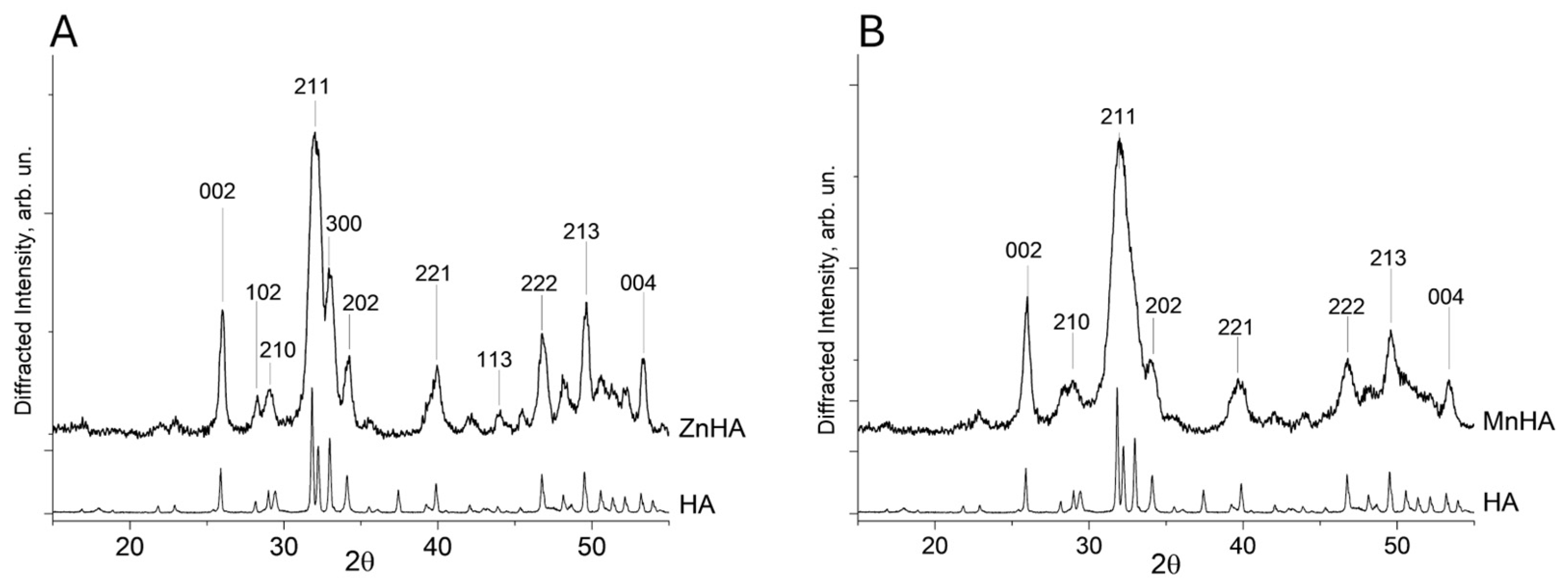
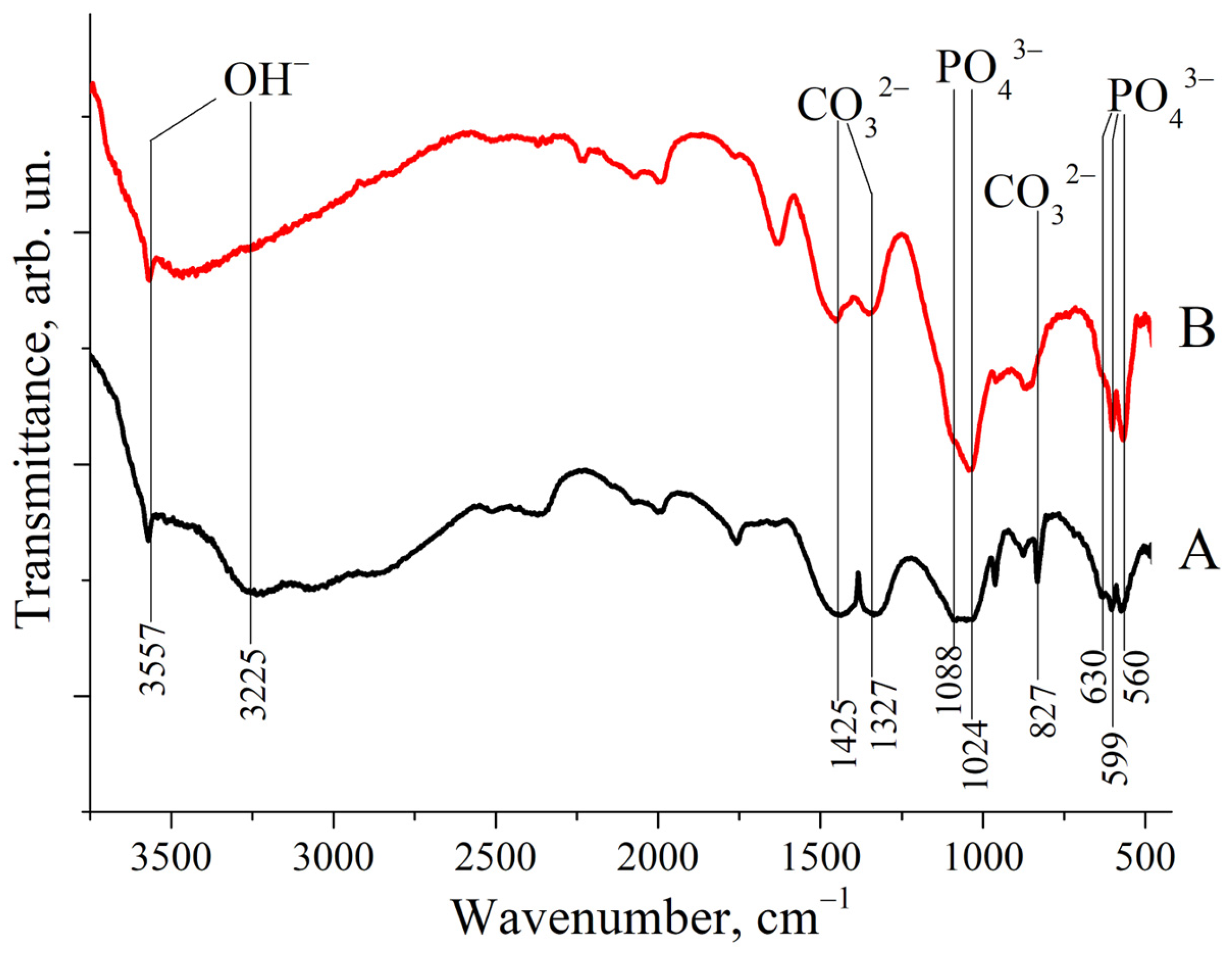
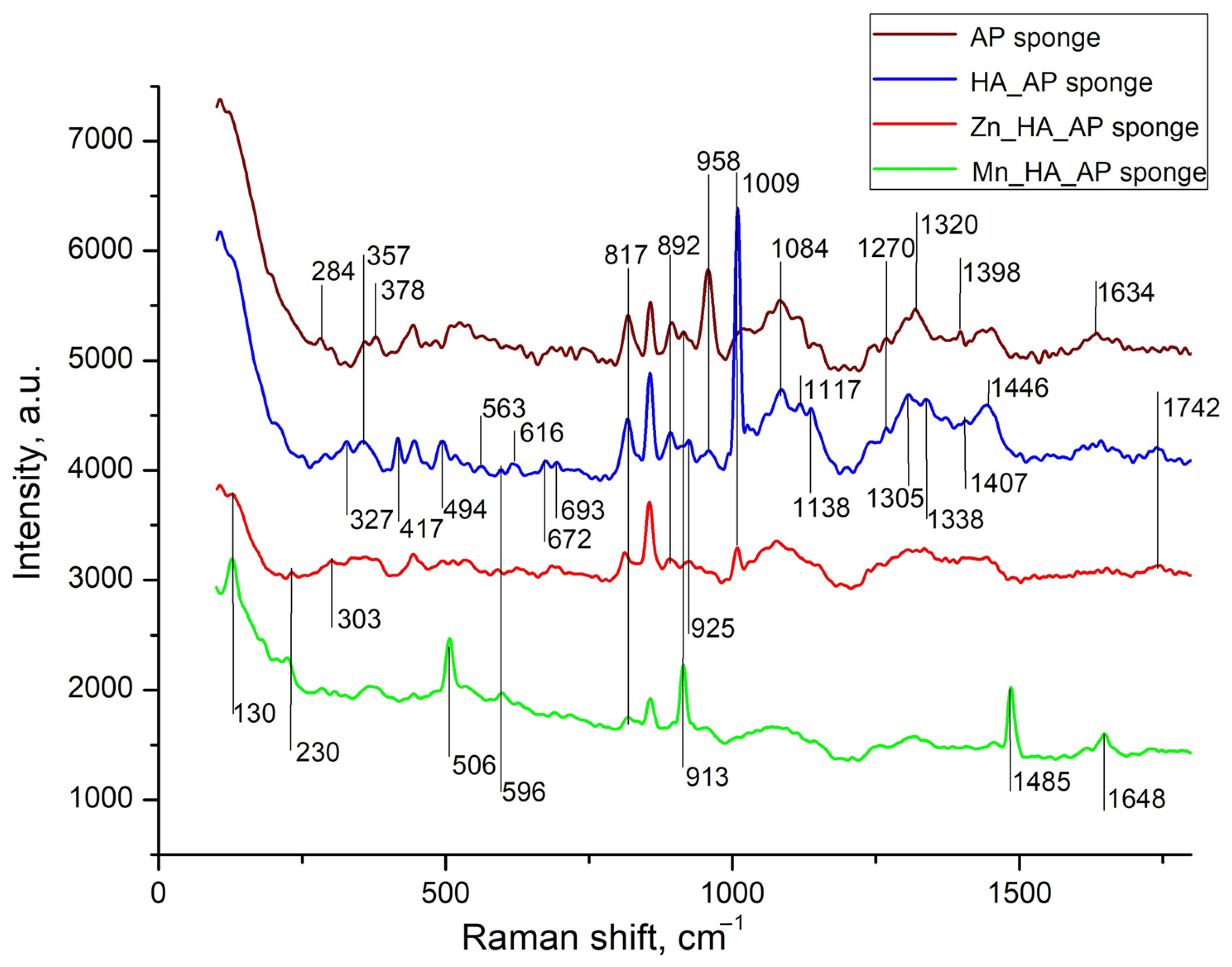
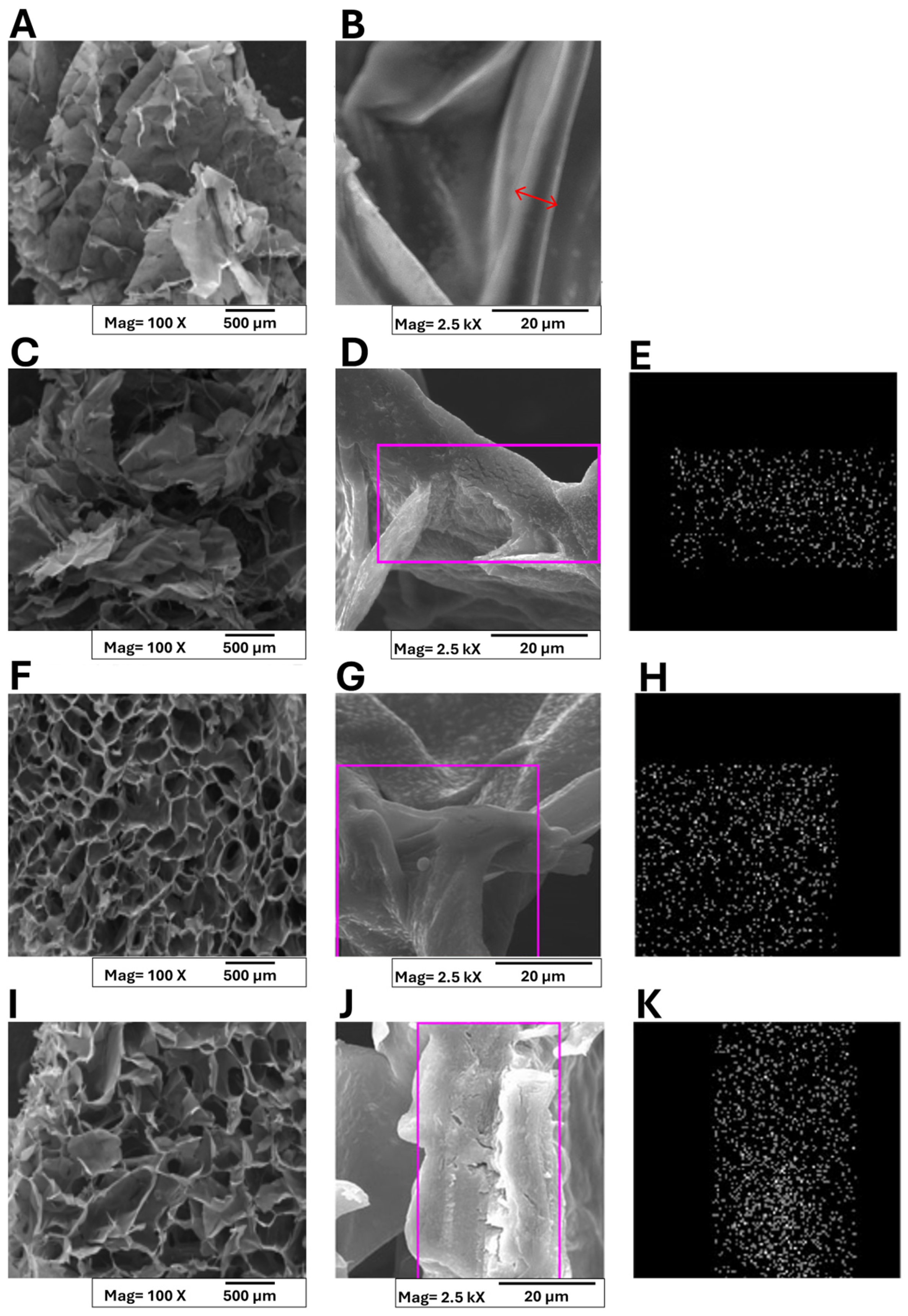
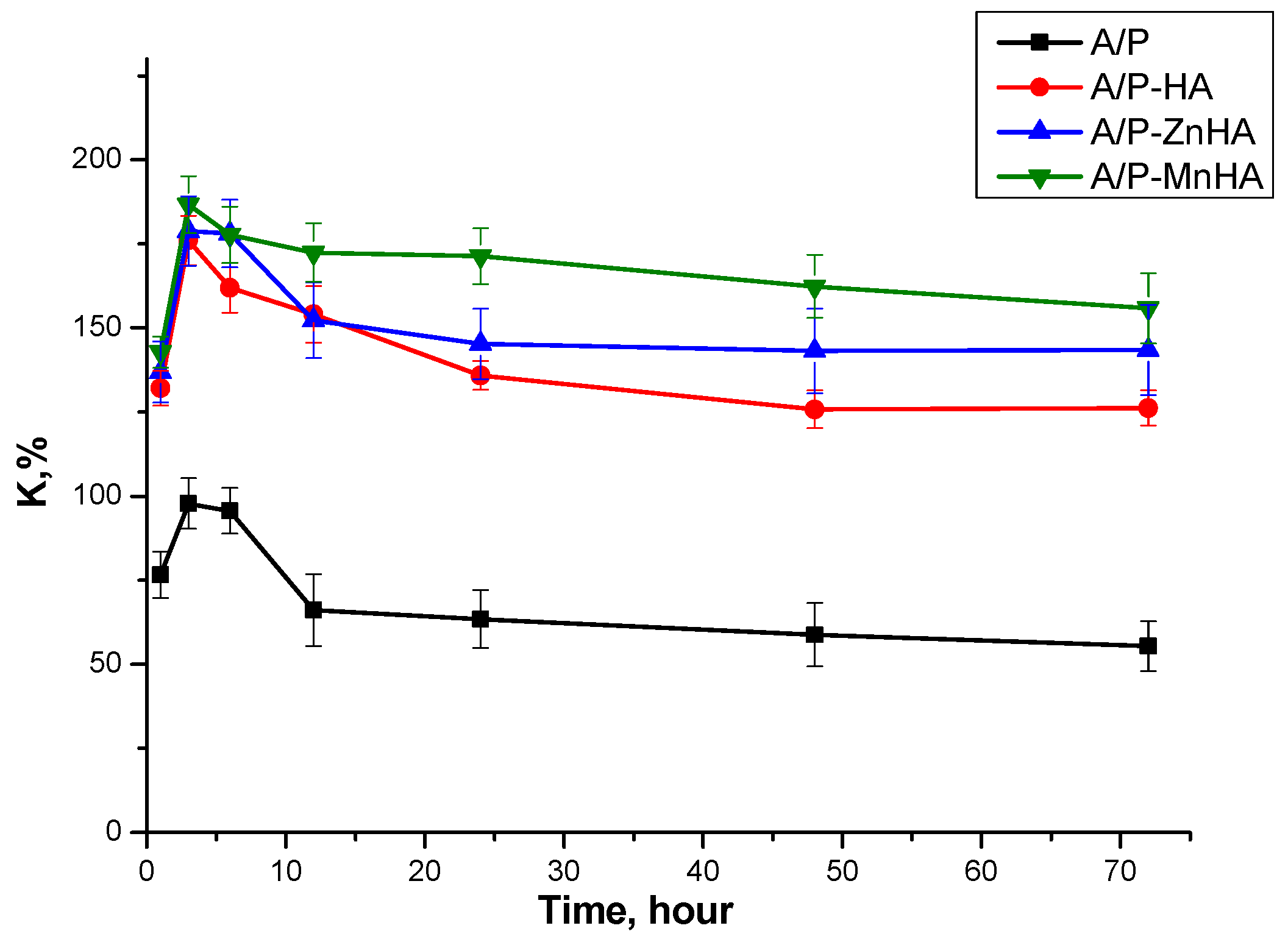
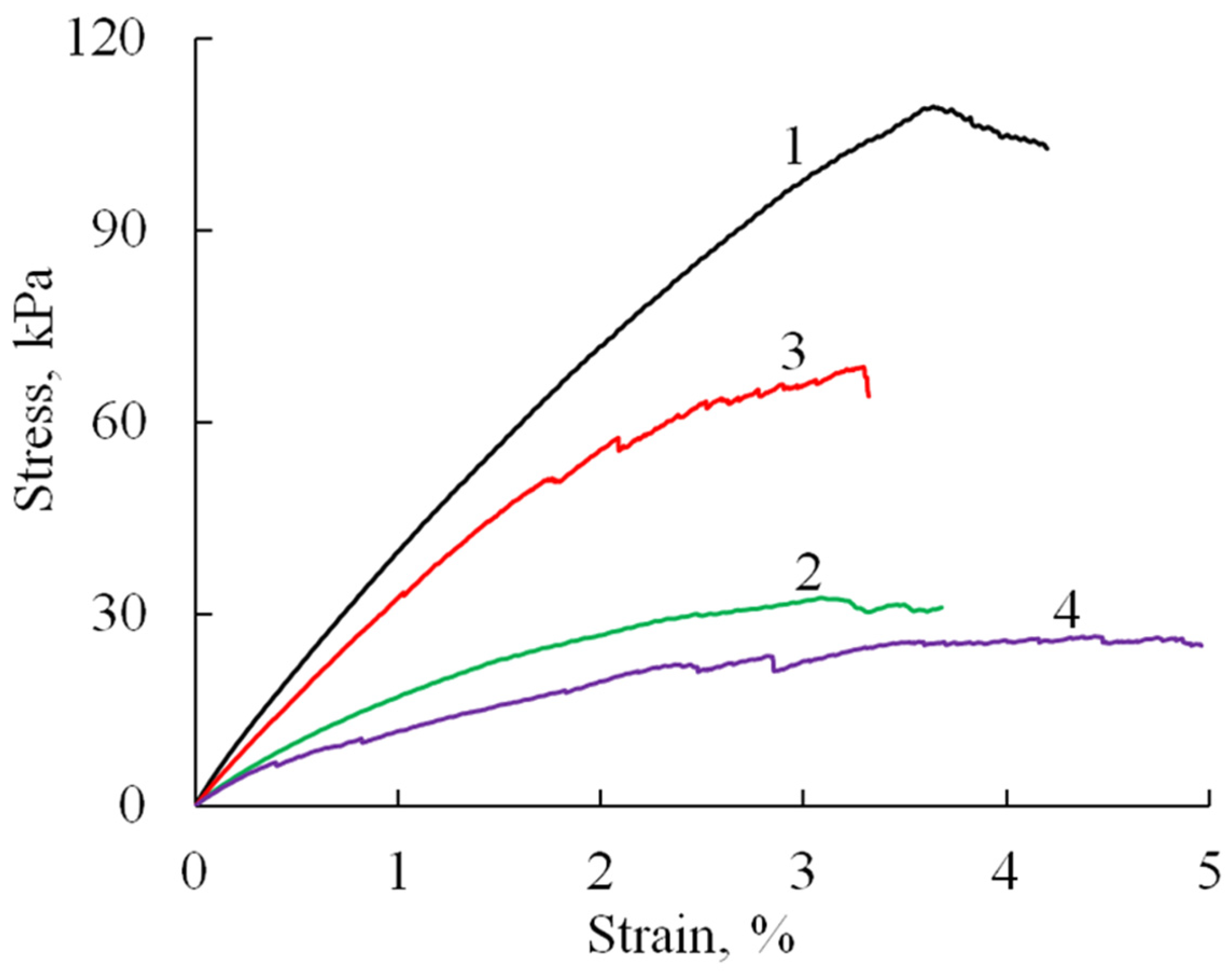
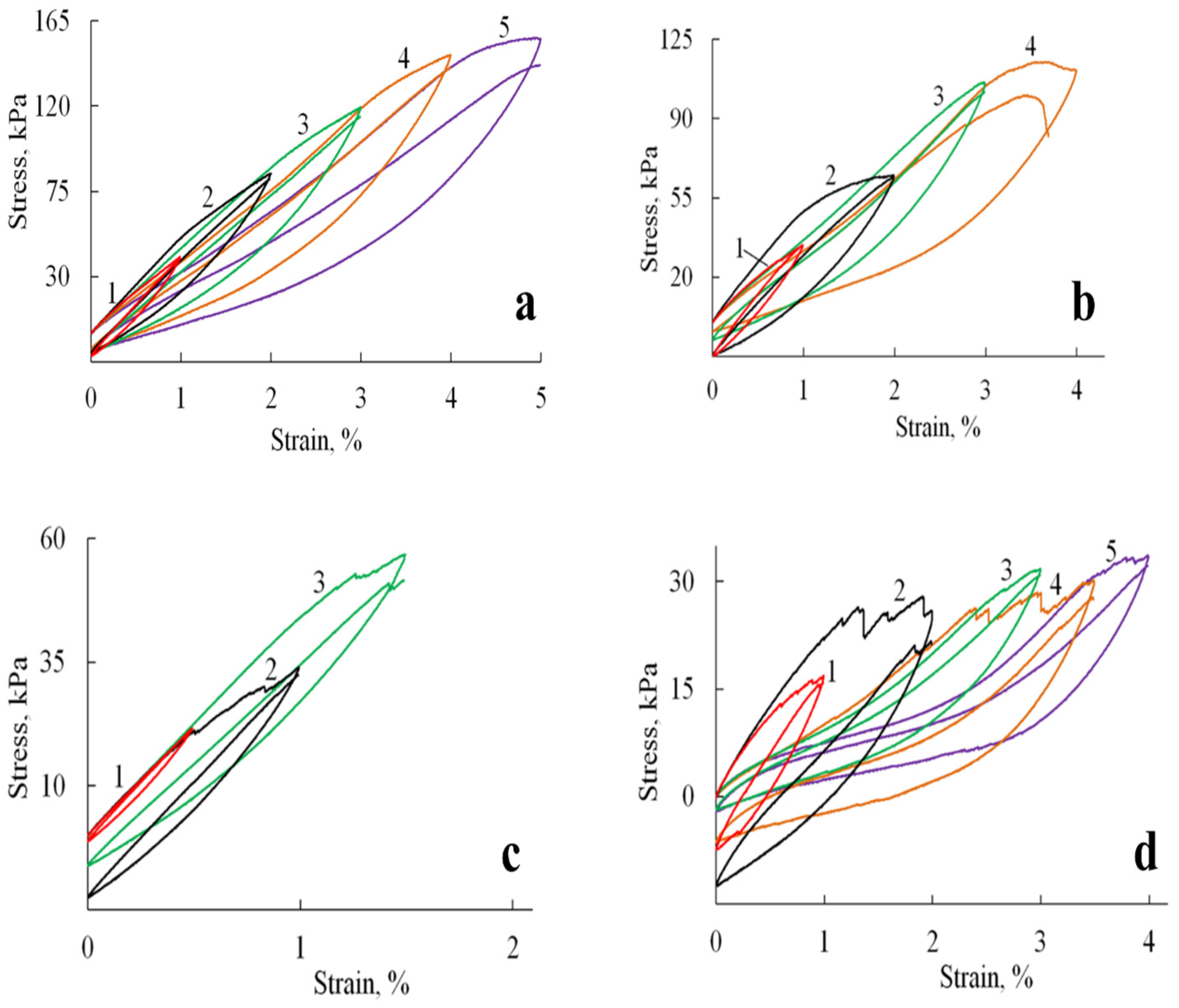


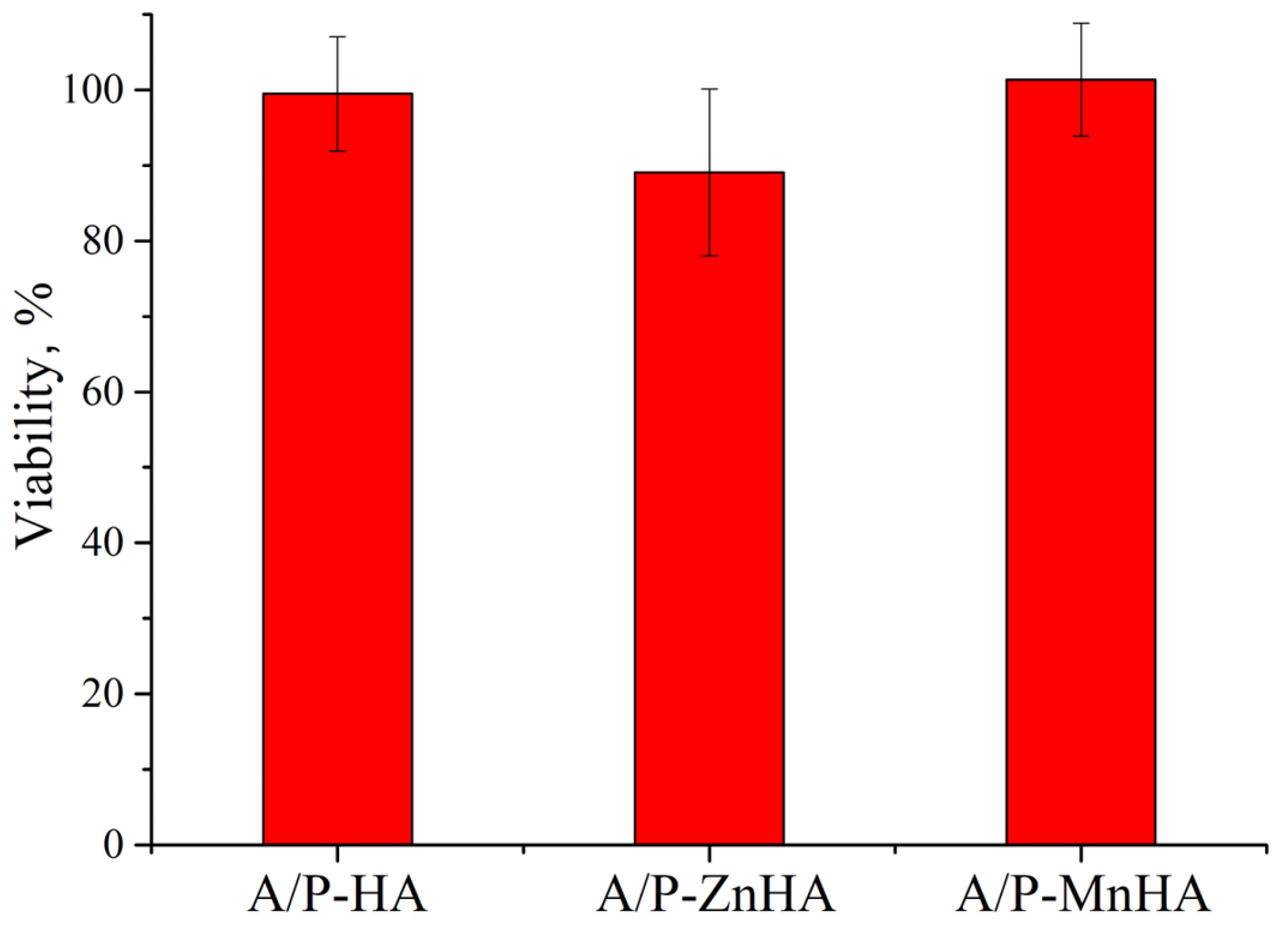
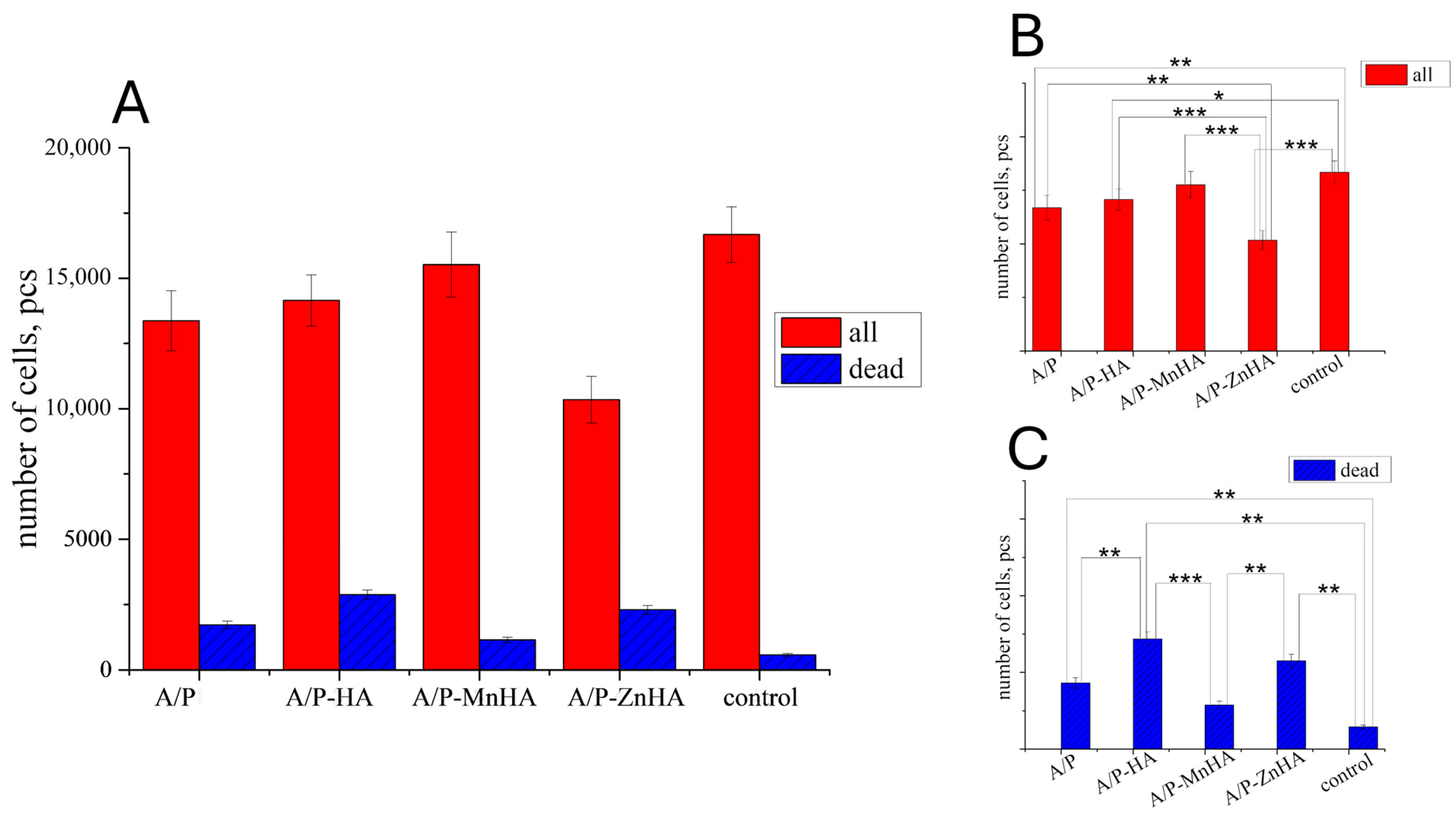
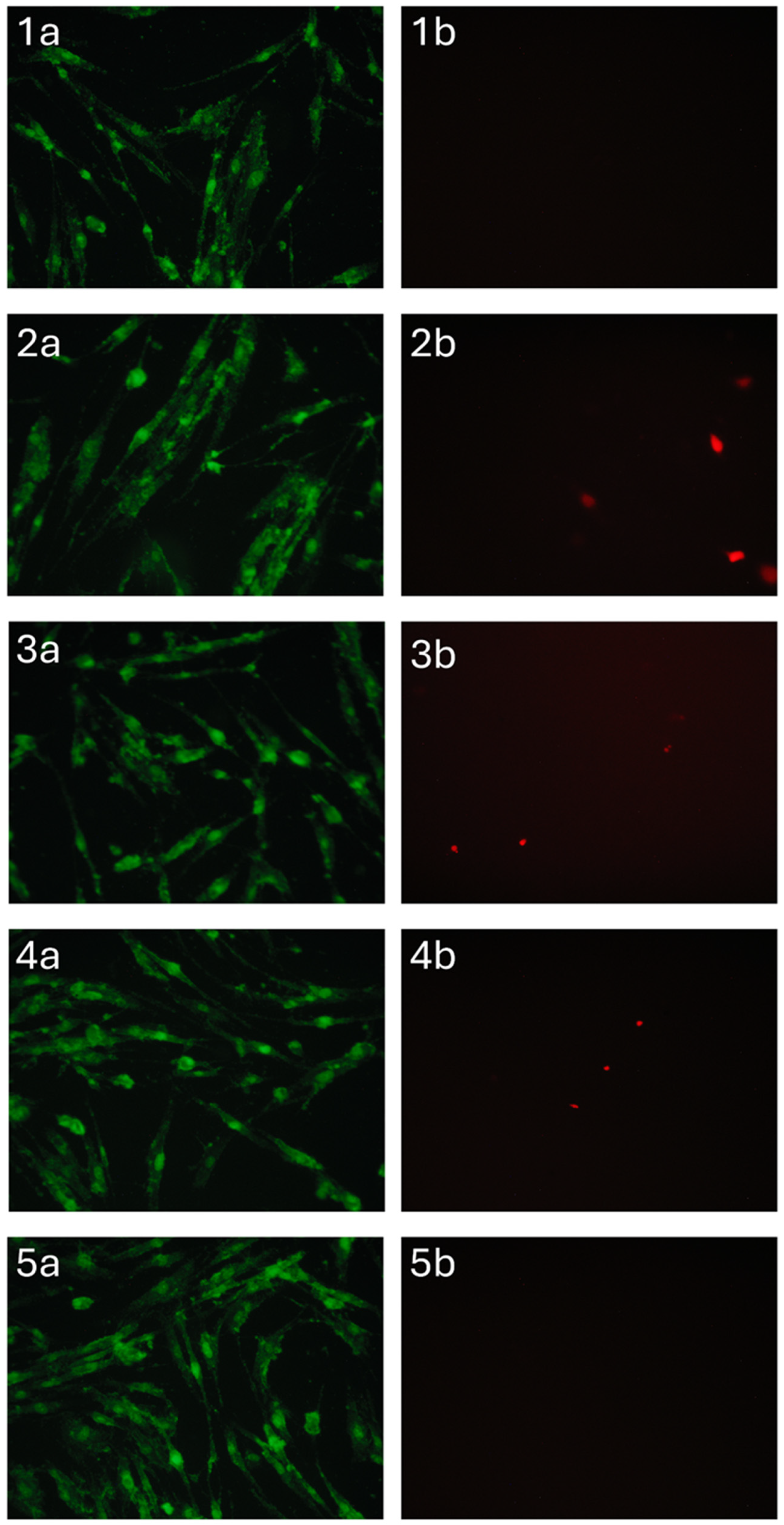
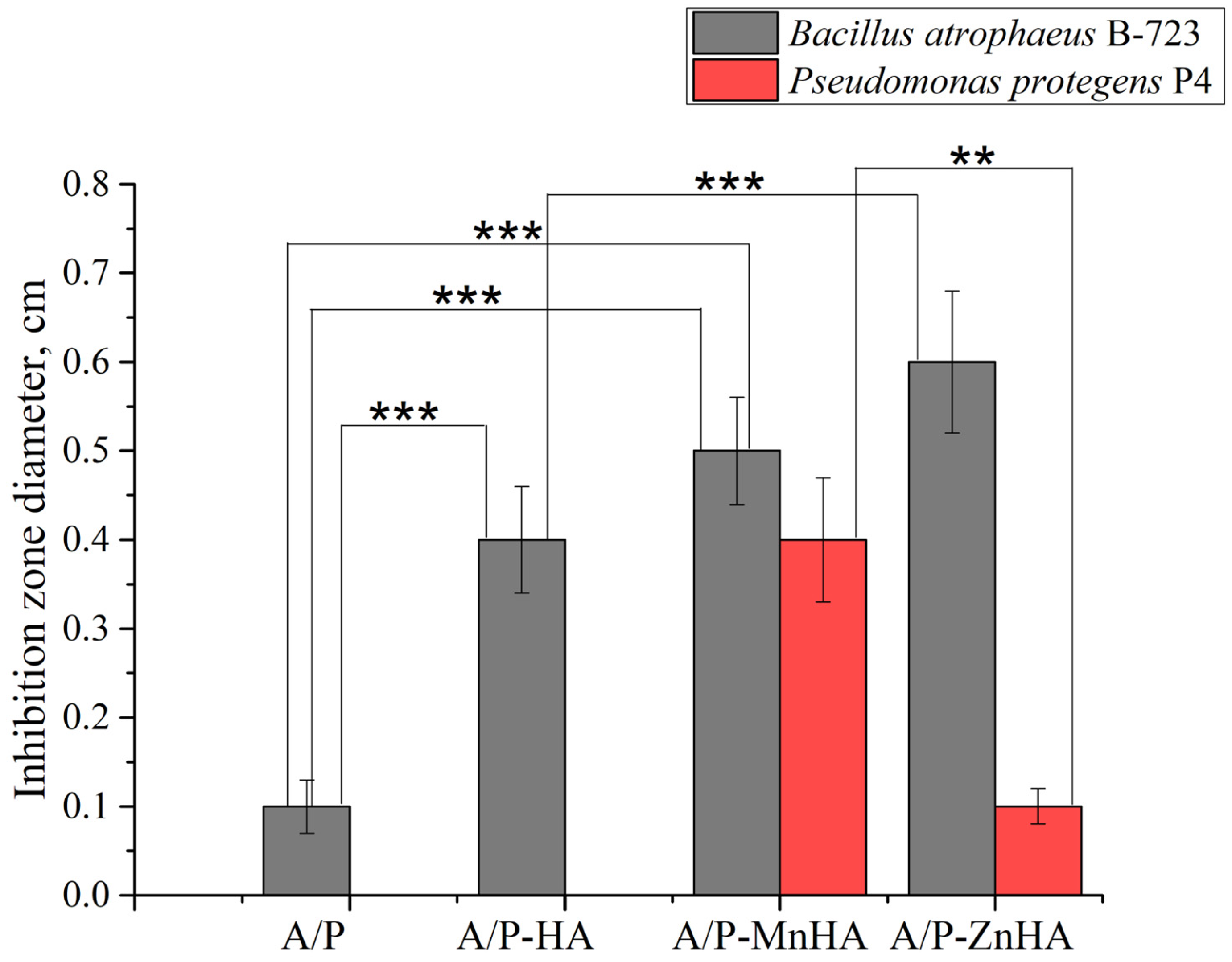
| Sample | Modulus of Elasticity, MPa | Strength, MPa | Breaking Elongation, % |
|---|---|---|---|
| A/P | 4.7 ± 0.5 | 0.10 ± 0.02 | 3.5 ± 1.0 |
| A/P + 0.5% HA | 2.5 ± 0.2 | 0.07 ± 0.01 | 5.5 ± 1.5 |
| A/P + 0.5% MnHA | 4.2 ± 0.4 | 0.06 ± 0.01 | 2.5 ± 1.0 |
| A/P + 0.5% ZnHA | 2.5 ± 0.3 | 0.03 ± 0.01 | 4.5 ± 1.5 |
| Sample | Region of Elastic Behavior | Limit | Sealing | |||
|---|---|---|---|---|---|---|
| Modulus, MPa | Elastic Limit Def., % | Def., % | Stress, kPa | Def., % | Stress, kPa | |
| A/P | 0.34 ± 0.04 | 8.5 ± 0.5 | 9 ± 2 | 28.2 ± 0.3 | 60 ± 4 | 79.1 ± 0.8 |
| A/P + 0.5% HA | 0.16 ± 0.02 | 8.5 ± 0.5 | 36 ± 3 | 37.3 ± 0.4 | 70 ± 5 | 87.9 ± 0.9 |
| A/P + 0.5% MnHA | 0.17 ± 0.02 | 15 ± 1.5 | 25 ± 2 | 32.1 ± 0.3 | 70 ± 5 | 97.8 ± 1.0 |
| A/P + 0.5% ZnHA | 0.19 ± 0.03 | 10 ± 1.0 | 13 ± 2 | 20.7 ± 0.2 | 73 ± 6 | 86.6 ± 0.9 |
Disclaimer/Publisher’s Note: The statements, opinions and data contained in all publications are solely those of the individual author(s) and contributor(s) and not of MDPI and/or the editor(s). MDPI and/or the editor(s) disclaim responsibility for any injury to people or property resulting from any ideas, methods, instructions or products referred to in the content. |
© 2025 by the authors. Licensee MDPI, Basel, Switzerland. This article is an open access article distributed under the terms and conditions of the Creative Commons Attribution (CC BY) license (https://creativecommons.org/licenses/by/4.0/).
Share and Cite
Davydova, G.A.; Fadeeva, I.V.; Trofimchuk, E.S.; Selezneva, I.I.; Mahamadiev, M.T.; Akhmetov, L.I.; Yakovsky, D.S.; Proskurin, V.P.; Fosca, M.; Yankova, V.G.; et al. Porous Osteoplastic Composite Materials Based on Alginate–Pectin Complexes and Cation-Substituted Hydroxyapatites. Polymers 2025, 17, 1744. https://doi.org/10.3390/polym17131744
Davydova GA, Fadeeva IV, Trofimchuk ES, Selezneva II, Mahamadiev MT, Akhmetov LI, Yakovsky DS, Proskurin VP, Fosca M, Yankova VG, et al. Porous Osteoplastic Composite Materials Based on Alginate–Pectin Complexes and Cation-Substituted Hydroxyapatites. Polymers. 2025; 17(13):1744. https://doi.org/10.3390/polym17131744
Chicago/Turabian StyleDavydova, Galina A., Inna V. Fadeeva, Elena S. Trofimchuk, Irina I. Selezneva, Muhriddin T. Mahamadiev, Lenar I. Akhmetov, Daniel S. Yakovsky, Vadim P. Proskurin, Marco Fosca, Viktoriya G. Yankova, and et al. 2025. "Porous Osteoplastic Composite Materials Based on Alginate–Pectin Complexes and Cation-Substituted Hydroxyapatites" Polymers 17, no. 13: 1744. https://doi.org/10.3390/polym17131744
APA StyleDavydova, G. A., Fadeeva, I. V., Trofimchuk, E. S., Selezneva, I. I., Mahamadiev, M. T., Akhmetov, L. I., Yakovsky, D. S., Proskurin, V. P., Fosca, M., Yankova, V. G., Rau, J. V., & Saceleanu, V. (2025). Porous Osteoplastic Composite Materials Based on Alginate–Pectin Complexes and Cation-Substituted Hydroxyapatites. Polymers, 17(13), 1744. https://doi.org/10.3390/polym17131744









